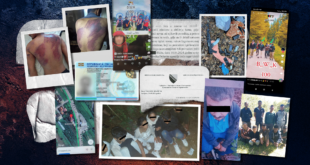KABUL, Afghanistan – NATO has an image problem in Afghanistan — and a U.S. soldier who fired a Humvee’s machine gun into a crowd of civilians after a deadly suicide bombing Saturday shows why.Despite the Taliban quickly claiming responsibility for the car bomb attack on a U.S. convoy that left four Afghan civilians dead, people on the street became enraged only after American bullets landed in the crowd, killing one and wounding two.
Some 50 to 100 people began chanting “Death to America,” and others jabbed their fingers at Afghan police.
“They are against us. They are against Afghans,” said one man, Abdul Rahim. He said the civilian deaths should be stopped. “Otherwise we will join hands and stand against them alongside the others” — a reference to the Taliban’s hard-line Islamic militants.
“They are killing Muslims,” he said.
Zalmai Khan, Kabul’s deputy police chief, and U.S. officials called the shooting an accident, saying the gun inadvertently fired when the soldier shifted it from one side to another.
But the gunfire was enough to change the headlines. International news Web sites no longer led with a suicide bomber killing four Afghans. One instead said: “U.S. forces kill Afghan haphazardly.” Another read: “U.S. troops kill Afghan civilians.”
The shooting came the same day that four senior officials in NATO’s International Security Assistance Force summoned journalists to discuss civilian casualties, which is hurting support — both in Afghanistan and in NATO’s European capitals — for the international Afghan mission.
An Afghan official at the briefing said civilian deaths “are currently the main concern” of Afghans, underlining the repeated calls from President Hamid Karzai for foreign troops to do more to prevent civilian casualties.
Speaking a day after a NATO defense ministers meeting in Belgium that stressed the need to avoid such deaths, the ISAF officials said they had avoided many casualties by calling off military missions that could have endangered civilians.
They also displayed a colorful graph showing the vast majority of civilian deaths are caused by Taliban bombs.
A much smaller, but still sizable, portion was attributed to the U.S.-led coalition, a separate command structure of 13,000 soldiers conducting anti-terrorist raids. Civilian deaths blamed on the 36,000-strong ISAF, which is responsible for fighting insurgents, represented the tiniest sliver.
But no matter which Western soldier fires a fatal gunshot, and even if the numbers pale in comparison to civilian deaths caused by the Taliban, Afghan anger is often turned on NATO.
“I feel we’re getting blamed for something we didn’t do,” said one senior ISAF official, who like others at the briefing insisted on not being quoted by name so he could speak more freely.
Fairly or not, Mustafa Alani, director of security and terrorism studies at the Dubai-based Gulf Research Center, said Afghan deaths at the hands of foreign soldiers are seen differently than Taliban attacks, which some see as an internal Afghan conflict.
“Generally people believe that the deaths of civilians at the hands of Americans are intentional,” Alani said.
“They don’t think with all this technology they can keep killing civilians. They believe the U.S. soldier must be more disciplined, and they expect a higher moral level, military discipline compared to the Taliban.”
The deadliest attacks on Afghan civilians by international forces this year have involved U.S. Special Forces, such as the soldiers who killed 19 civilians near Jalalabad after a suicide car bomb attack in March.
A U.S. military spokesman, Maj. Chris Belcher, said the U.S.-led coalition does all it can to prevent civilian deaths. He accused the Taliban of staging attacks designed to put civilians in danger.
The suicide car attack Saturday — the fifth suicide bombing in Kabul this year — came against a convoy of U.S. contract workers with the security company DynCorp and U.S. military personnel. Four Afghan civilians died in the blast and five were wounded, officials said.
Violence has been escalating, particularly in Afghanistan’s volatile south, where a suicide bomber attacked a NATO convoy in Uruzgan province Friday. The explosion killed 10 people, including five children.
Kabul has mostly been spared the worst of this year’s bloodshed, which has claimed 2,400 lives, mostly insurgents, according to an Associated Press count based on figures from U.S., NATO, U.N. and Afghan officials.
But on Sunday, a bomb ripped through a police bus in a crowded civilian area in the city, leaving at least 55 people killed or wounded, an official and witnesses said.
 Eurasia Press & News
Eurasia Press & News


